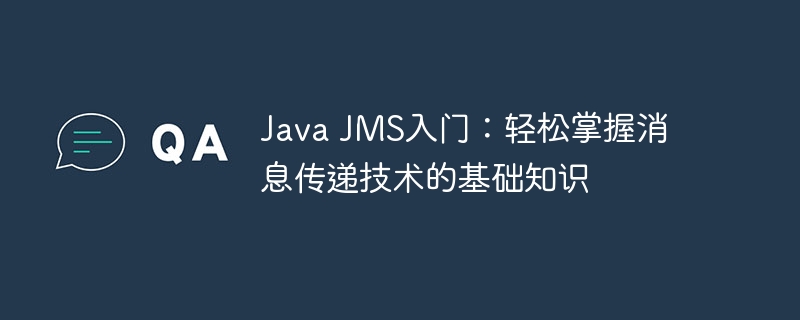

php Xiaobian Xigua helps you easily master the basic knowledge of Java JMS messaging technology. Java Message Service (JMS) is a Java API for sending messages between applications, providing a convenient communication method for building distributed systems. Through the introduction and guidance of this article, you will understand the basic concepts of JMS, message model, message types, and how to implement message delivery in Java applications. Let's explore JMS in depth together and improve your technical skills!
Java JMS is a Java api for establishing, sending and receiving messages. It provides reliable messaging capabilities and is ideal for distributed systems and enterprise-level applications. Messaging systems can send messages from one application to another, even if the two applications are on different machines.
2. JMS API
The JMS API defines a series of interfaces and classes for sending and receiving messages. These interfaces and classes include:
3. Message passing model
JMS supports two messaging models: publish/subscribe and point-to-point.
4. Using Java JMS
The following is a code example that demonstrates how to send and receive messages using Java JMS:
import javax.jms.*;
public class HelloWorld {
public static void main(String[] args) throws JMSException {
// 创建连接工厂
ConnectionFactory connectionFactory = new ActiveMQConnectionFactory("tcp://localhost:61616");
// 创建连接
Connection connection = connectionFactory.createConnection();
// 启动连接
connection.start();
// 创建会话
Session session = connection.createSession(false, Session.AUTO_ACKNOWLEDGE);
// 创建主题
Topic topic = session.createTopic("HelloWorld");
// 创建消息发布者
MessageProducer producer = session.createProducer(topic);
// 创建消息
TextMessage message = session.createTextMessage("Hello, JMS!");
// 发送消息
producer.send(message);
// 创建消息消费者
MessageConsumer consumer = session.createConsumer(topic);
// 接收消息
TextMessage receivedMessage = (TextMessage) consumer.receive();
// 打印消息
System.out.println("Received message: " + receivedMessage.getText());
// 关闭连接
connection.close();
}
}In this example, we first create a connection factory, and then use the connection factory to create a connection. Next, we created a session using the connection and then created a topic using the session. Next, we create a message publisher to send messages to the topic. Finally, we create a message consumer to receive messages from the topic.
5 Conclusion
Java JMS is a powerful messaging API that helps you achieve reliable messaging in distributed systems and enterprise-level applications. This article introduces the basic concepts and usage of Java JMS and hopes to be helpful to you.
The above is the detailed content of Getting Started with Java JMS: Master the Basics of Messaging Technology Easily. For more information, please follow other related articles on the PHP Chinese website!




